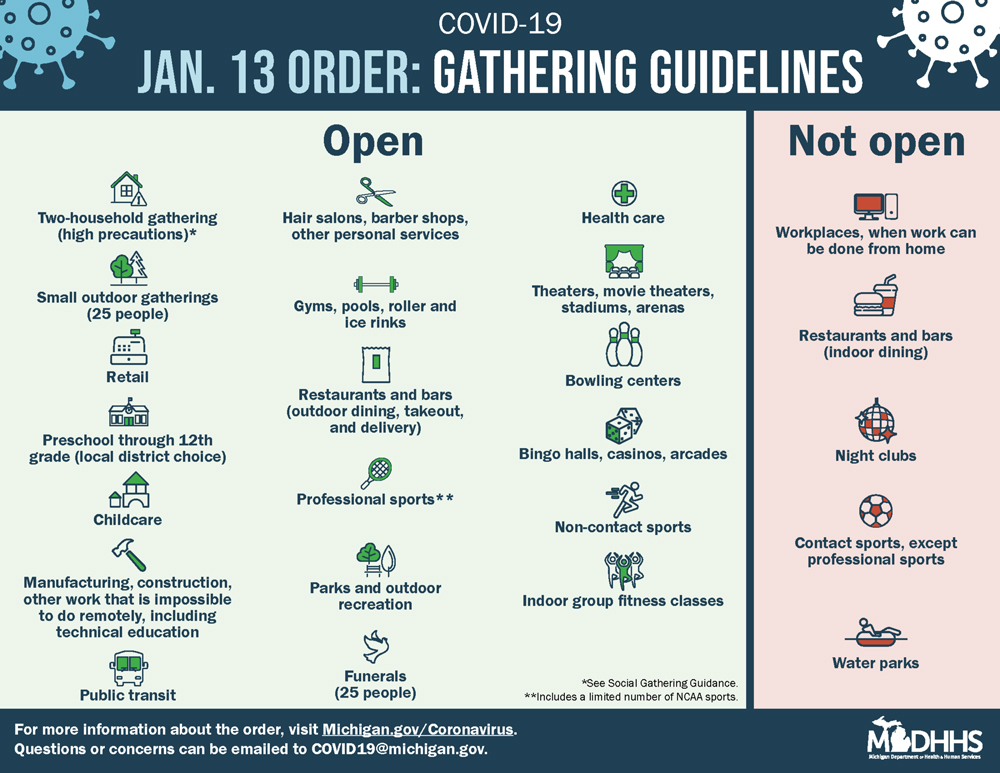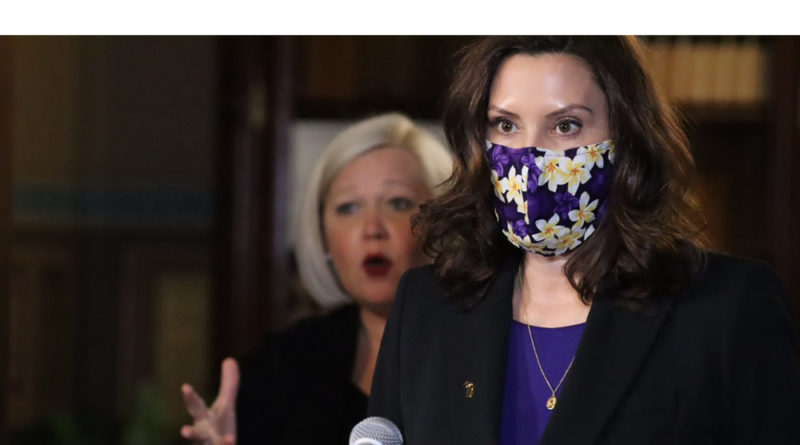New MDHHS epidemic order allows indoor group exercise, non-contact sports
Gatherings remain limited, group exercise and non-contact sports now open to support mental and physical health; indoor dining remains closed through at least Feb. 1
In the ever-changing world of the pandemic, new orders have come from the Michigan Department of Health and Human Services (MDHHS) updating its epidemic order. The Jan. 13 order allows re-opening of some activities but postponed the opening of others including indoor dining and high school sports. Restaurants are allowed to serve via takeout or outdoor dining while basketball and wrestling may not begin competition until Feb. 1.
Those activities allowed are where Michiganders can remain masked and socially distanced, as this has been scientifically shown to slow the virus. This includes indoor group exercise and non-contact sports. The new order is effective Saturday, Jan. 16 and will last until Sunday, Jan. 31.

“The efforts we have made together to protect our families, frontline workers and small business owners are working. While there has been a slight uptick in our percent positivity rate, our cases per million have plateaued and more hospital beds are becoming available. Today, we are confident that MDHHS can lift some of the protocols that were previously in place,” said Gov. Gretchen Whitmer.
“Michigan is once again standing out as a nationwide leader in fighting this virus, and we must continue working to keep it that way. One of the most important things Michiganders can do is to plan to get the safe and effective vaccine when it’s available to you. And as always, mask up and maintain six feet of social distancing. We will end this pandemic together.”
Indoor residential gatherings remain limited to 10 people and two households. MDHHS continues to urge families to avoid indoor gatherings or to pick a single other household to interact with consistent with guidance issued previously by MDHSS.
106th District state Rep. Sue Allor (R.-Wolverine) is opposed to extending the order pointing out that Michigan is currently one of just two states, along with Illinois, to have a complete ban on in-person dining.
“Michigan has nearly 17,000 eating and drinking establishments which employ almost half of a million people. It’s a huge industry for our state and local economies, and provides livelihoods for many Michiganders. But the governor continues to act unilaterally, making decisions using data and science she refuses to share and referencing undefined thresholds to keep them limited or closed altogether. We are now going into month 10 of her ‘three-week plan to flatten the curve.’ Enough is enough,” Allor said.
According to the Michigan High School Athletic Association (MHSAA), girls’ gymnastics, girls’ and boys’ bowling, and girls’ and boys’ swimming and diving, as “non-contact” sports, may begin competition Jan. 22 and gymnastics and bowling Jan. 25. Masks will be required of all participants except when they are actively participating in gymnastics and swimming and diving. Spectators will be capped at 100 persons in school gyms or 250 in stadiums and arenas, per MDHHS orders.
Basketball, competitive cheer, ice hockey and wrestling are considered “contact” sports and may begin non-contact practices Jan. 16, with their first competitions scheduled for Feb. 1. Because of the later start to competition schedules in those sports, the MHSAA will adjust its tournament dates for those four to conclude on later dates than what is currently scheduled.
“We are glad to have three more sports join skiing in returning to full activity, but we understand the disappointment and frustration on the part of our athletes and coaches whose sports are not yet able to restart completely,” MHSAA Executive Director Mark Uyl said. “We will continue to adjust schedules to provide all of our winter teams as substantial an experience this season as possible, as part of our greater plan this school year to play all three seasons to conclusion.
“We continue to make progress in our fight against this virus, and expanding vaccination to healthcare workers, long-term care residents and staff, some essential frontline workers and those age 65 and older is bringing us closer to ending the pandemic,” said Dr. Joneigh Khaldun, chief medical executive and chief deputy for health at MDHHS. “It is important that everyone continues to do their part by avoiding gatherings, wearing masks properly and social distancing. This remains just as important, even as the safe and effective vaccine is being administered, to protect those who are not yet able to be vaccinated.”
Previously, MDHHS had identified stabilization or declines in three metrics as critical for relaxing protocols. Although Michigan saw improvements across all three following the “pause” implemented in mid-November, some numbers have plateaued or begun to increase in recent days:
- Hospital capacity dedicated to COVID-19 patients has been in 13-day decline, with current capacity is at 12 percent for beds with COVID-19 patients. Peaked at 19.6 percent on Tuesday, Dec. 4.
- Overall case rates: increasing, currently at 266 cases per million. Peaked at 740 cases per million on Saturday, Nov. 14 and declined to a low of 239 on Friday, Dec. 25
- Positivity rate: plateauing; currently at 9.1percent after reaching a low of 8.1percent on Monday, Dec. 28 and increasing up to 10 percent since then.
“We are reopening cautiously because caution is working to save lives. The new order allows group exercise and non-contact sports, always with masks and social distancing, because in the winter it’s not as easy to get out and exercise and physical activity is important for physical and mental health,” said MDHHS Director Robert Gordon. “We are glad that we made it through th
Families are encouraged to stay home as much as possible to maintain momentum and to protect loved ones. Families are also encouraged to Mask Up, Mask Right, using guidance for what masks to wear and how to wear them.

